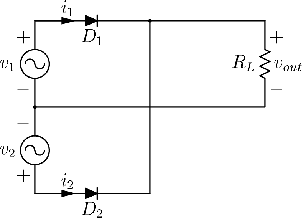 |
In the half-wave rectifier the voltage is zero for half of the cycle. Full-wave rectifiers are designed using two or more diodes so that voltage is produced over the whole cycle.
Figure 83 shows a full-wave rectifier designed using two diodes and a center-tapped AC supply (i.e. center-tapped transformer).
The waveforms are shown in Figure 84. The center tapping implies that the two source voltages v1 and v2 are a half cycle out of phase. We see that diode D1 conducts when source v1 is positive, and D2 conducts when v2 is positive, giving the waveform vout.
The average or DC value of the waveform vout is now
Figure 85 shows a bridge rectifier built from four diodes and a single AC source. The waveform of vout is the same as for the center-tapped full-wave rectifier.
The average voltage for the bridge rectifier is the same as in (79) but the
peak inverse voltage is
ANU Engineering - ENGN2211